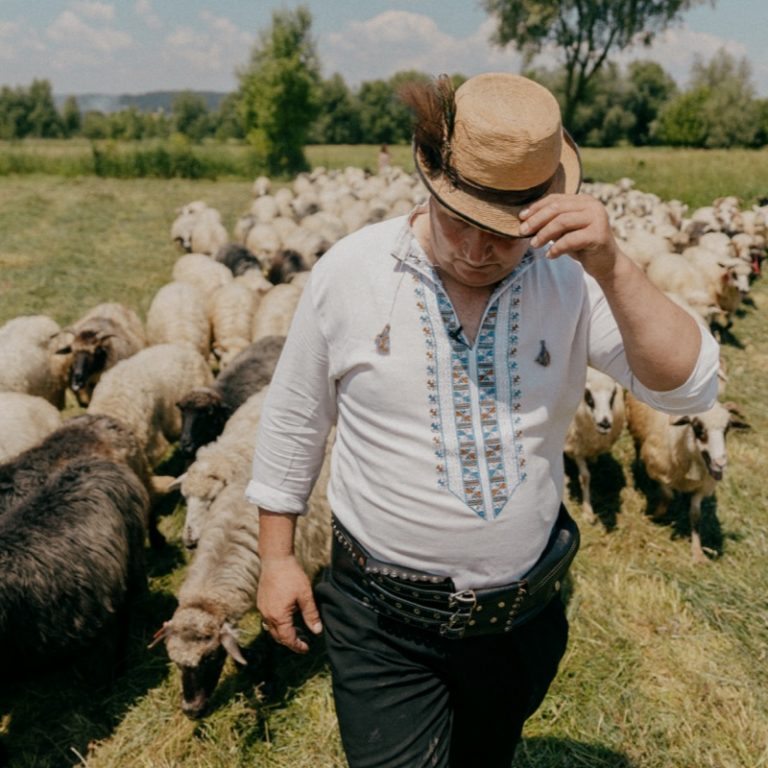Romanians have been living on Ukrainian land since the 14th century. Back then, Vlachs from Maramureș and Southern Transylvania, who are now considered the ancestors of modern Romanians and Moldovans, began to settle in the territories of modern Zakarpattia and Bukovyna. Later, many Romanians settled in Bessarabia. Today there are over 150 thousand ethnic Romanians in Ukraine. Over 30 thousand of them are clustered in the settlements along the borderline in Zakarpattia, where they coexist with Ukrainians, Hungarians, and other ethnic minorities, speak the local dialect of Romanian, and master several languages from childhood.

Nuțu Bateala wakes up at 3 am every day to cut hay and tend to his sheep. He then milks the sheep, and uses the milk to make ten-kilogramme wheels of cheese. Three times a week, he and his wife bring the cheese, called vurda, to the local markets in Solotvyno, Serednie Vodiane, or Velykyi Bychkiv. Nuțu is a sheep farmer and a shepherd from Solotvyno village in Zakarpattia. There are only a few people like him left.
Vurda
A sort of cheese made of whey with addition of fresh sheep milk. Vurda is similar to ricotta in the way it is produced.— I’ve been looking after sheep ever since I was a kid, from the age of seven, when a collective farm was here. These days there are very few sheep farmers around here, I’m nearly the only one. There’s another farmer down the hill, but he keeps no more than a hundred sheep, and that’s it.
Nuțu was born in Serednie Vodiane (formerly called Serednia Apsha, or Apșa de Mijloc in Romanian) in a mixed family: his mother is Romanian and his father — Ukrainian. He married over 20 years ago and moved to Solotvyno, where he started his own farming business. Today it is run by his entire family.
— Everyone is involved: my daughter, my son-in-law, my grandson, my wife. It’s just us, we don’t have any outsiders. Our family milks the sheep — I taught my wife and daughter how to milk them properly.
One winter there was a fire on Nuțu’s farm. It burned the entire farm and all of the hay. Nuțu had to buy hay to keep the sheep alive through the winter.
— The sheep were crying as the farm burned. Then, I began to cry because I knew I had nothing to feed them.
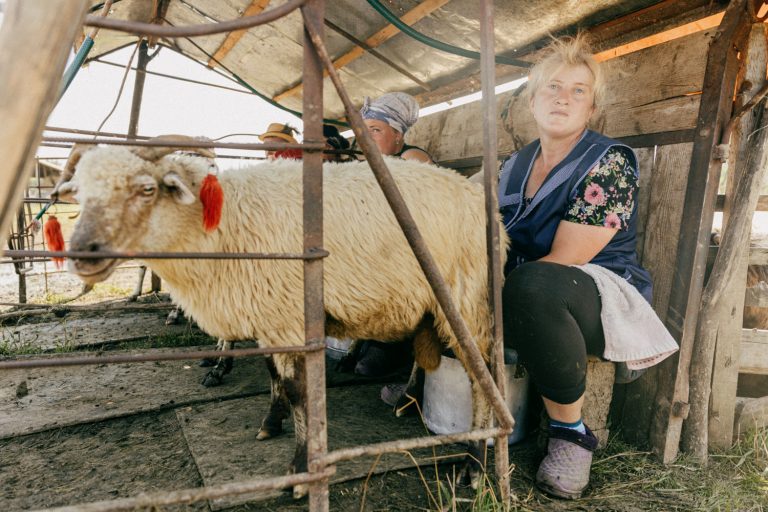
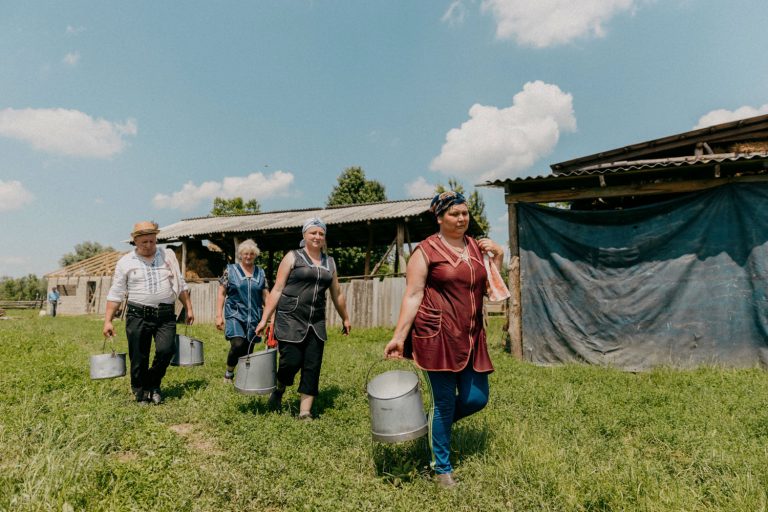
slideshow
Romanians from nearby villages came to help Nuțu restore his farm following the accident. He now has the biggest sheep farm in the area — with over 300 sheep. And it all started from just 20 or 30 animals.
— I milk them three times a day: early in the morning at three, just before noon at eleven, and then in the evening at five. Rain or shine, I have to milk them. They’d go mad if I didn’t.
Nuțu speaks Romanian at home. He knows Ukrainian well, because he learned it at school and because he often speaks it with his customers while selling cheese in the mountains or at the local markets.
When making vurda, liquid whey protein is separated from the milk. This almost clear liquid is rich in nutrients, and is a favourite drink of the farmer’s family.
— I don’t drink much water. Instead, I prefer to drink the liquid whey that comes from making vurda. Here, try some.
Nuțu sells the cheese he makes at the local markets and has many loyal customers. His neighbours often buy some cheese too.
— People fell in love with it because it’s a pure product. When my grandfather was alive, our family made this cheese all the time. These days, manufacturers put all those chemicals in their cheese and expect people to eat it. As if the foul air we have is not enough, they offer us foul products.
“Our entire diet is made up of cheese, salted meat, vurda, and onions” — the farmer adds.

I’ve loved this ever since I was a kid
According to Nuțu, there are very few sheep farmers left in the surrounding villages. He once knew some shepherds (both Romanian and Ukrainian) in Dibrova (Nyzhnia Apsha), Serednie Vodiane, Rakhiv, Tiachiv, Dubove.
Nuțu Bateala knows quite a few young lads in Rakhiv who help their fathers or grandfathers look after their sheep, but in Solotvyno, the majority had been working in a salt mine until it closed in 2012. Nuțu says, the sheep farmers of old have all gone, and the young are not very keen on keeping sheep.
— They are not keen because it’s hard work to get up early, get drenched in the rain with the sheep. Young people prefer their phones and computers. They are still keen on eating cheese, yet they complain about its price.
The farmer loves his business and stays in his home village Solotvyno, which is dear to him.
— I’ve liked sheep ever since I was a kid. Everytime I hear their bells tinkling, I get goosebumps. I did not see the point in looking for work somewhere else. Ever since I was little, I enjoyed playing the trembita, milking the sheep, and making cheese. And where would I go? Going abroad looks like the only feasible option, but I’m too old for that now. My place is here.

His trembita is made of metal, it’s a shorter version that fits into a car boot, so you can take it anywhere. Nuțu has another one — three metres long — that one is not suitable for a car. In the olden days, there were more trembita players, who would play them in mountain meadows, he recalls.
Trembita
A Ukrainian folk wind musical instrument similar to alpine horn. It is tube shaped with no valves, and is sometimes wrapped in birch bark.As Nuțu recalls, the local shepherds used trembita sounds instead of a clock: if the sounds could be heard, it was time to milk the sheep. Nuțu learned to play the trembita from the players of old.
— There were older people, and I was among them, together with my brother and father. I have loved playing since I was little and have been playing for nearly 37 years now.
Nuțu thinks of himself as Romanian Ukrainian.
We asked him if his sheep have ever crossed Romania’s borders — as the state border is very close. He replied: “No, no. We do look after them, you know, we really do”.

Solotvyno, a village on the border
Vitalii Ona, a historian by profession and ethnic Romanian, was born in Solotvyno. He studied in Odesa first, and then got his master’s degree in history in Romania. Romania to him is a ‘country across the river’, as it is to many other residents of the villages on the border.
— My mother is from the nearby Nyzhnia Apsha village, my father’s family is from Bila Tserkva, and my place of birth happened to be just in the middle, in Solotvyno. If you look at the map, you can see it’s geographically halfway between those places.
Right through this village on the state border runs the road to the border checkpoint ‘Solotvyno — Sighetu Marmaţiei’, where many people cross the border every day. For Solotvyno residents visiting the nearby Sighetu city is the same as visiting a neighbouring street, Vitalii says.
Long ago all this was one land — Maramureș (‘Great Muresh’ in Romanian). Since the 14th century, it was a part of the Hungarian kingdom, then it became a territory of Poland, then of the Ottoman Empire, of the Russian Empire, and finally of Austria-Hungary.
After World War I and the dissolution of Austria-Hungary, Maramureș was divided: its southern part was given to Romania, and the northern one to Czechoslovakia. The border was drawn by the Tysa river. There were many Ukrainians who stayed on the Romanian side across the Tysa. And likewise, many Romanians ended up on the other side of this new border.
Later, World War II led to yet another geopolitical change: the Soviet Union signed an agreement with Czechoslovakia, and Zakarpattia (along with the northern part of Maramureș) became a part of the Ukrainian Soviet Socialist Republic. This is how the Romanians of Zakarpattia ended up in independent Ukraine, living in the same homes for many generations.

Zakarpattia is a place of erased borders. Today this is the most multiethnic region of Ukraine. Historically, Ukrainians, Romanians, Hungarians, and other ethnic groups have all been living next to each other in Solotvyno.
— We live in harmony with Hungarians, Ukrainians, Russians, Jews, Germans. That’s a typical Zakarpattia, what else can I say.
Until the 1990s, the proportion of Hungarians and Romanians in the region was roughly equal. But then many Hungarians returned to Hungary. Now, the majority of population in the village is ethnic Romanian.
— For local people it does not make any difference if you’re Hungarian or Romanian. Men and women from both nations happily marry each other. Everything here is mixed together. It is quite common here to speak four or even five different languages.
According to Vitalii Ona, until recently you could see three flags in front of the Solotvyno village council. The Romanian flag was in the middle, because the chairman of the council was Romanian. On either side there was a Hungarian flag (because the deputy chairman was Hungarian) and a Ukrainian flag (to honour the secretary’s origin).
— We had three flags here in one row, each of a different state, and no one raised any objections. It’s very pleasing to see how people here live in harmony.

Salt, and Romanian houses
People began to mine salt in Solotvyno during the times of the Roman Empire. Hungarians further drove the salt mining business, with the place becoming Hungary’s ‘Eldorado of salt,’ says Vitalii.
Due to intensive mining over the last decades, the topography of the village has been turning into a karst landscape with sinkholes. The mines become flooded and are closed. The resorts and residential areas built around the salt lakes are in a high-risk zone.
— A chasm is forming there. It’s quite a dangerous place, and yet many people still visit it and take photos. When the salt mine was closed, it had the same effect on the village as cutting off a person’s oxygen supply.
Since 2013, because of the sinkholes appearing regularly, the Solotvyno resort has been declared an emergency zone. But Solotvyno residents refuse to move to the evacuees settlement in nearby Tereblia.
Half of the TV stories about Romanians of Zakarpattia would show their enormous houses, real mansions with tens of rooms. This is how Nyzhnia Apsha (Dibrova), where many entrepreneurs live, is often shown in the media. The principle of “making your house at least a brick taller than the one of your neighbour” is clearly visible all around here, the locals say. Vitalii is certain this is mostly typical of Romanians in Zakarpattia.
— Many of the locals (from Nyzhnia Apsha) went to Russia as migrant workers in the 1990s. This tendency to build large houses comes from Rublyovka (a prestigious residential area in the suburbs of Moscow. — ed.). Those big bosses wanted to show off their wealth, and built huge mansions. As migrants returned home, they brought that tradition with them: the bigger the house, the more respected the owner.

In Solotvyno you can see less of that. These days, another trend is coming from Romania: building small houses with solar panels and modest gardens.
The architecture of Solotvyno developed intensively under Czechoslovakian rule. Some buildings from that period can still be seen, although there are very few left. Vitalii shows the only authentic Romanian house which remains in Solotvyno. You can still find many of those in modern Romania.
— In authentic Maramureș architecture, no bricks were used, only wood and clay. Traditional elements include the earthen floor, small windows, a small front door, and a front garden. Even today in the villages you can see elderly people sitting in those small front gardens on their benches near the window.
Romanians would usually have a storage space in the attic, where they would sometimes store hay. It was believed that in wet weather the hay would protect the house from dampness, and during frosty winters it would preserve the heat.

The Romanians of Ukraine
Historians are still unsure of the origins of the Romanian people. Few historical sources remain, but the generally accepted version is that Romanians and Moldovans are descendants of Vlachs, who lived in this land during the Middle Ages, leading a semi-nomadic life.
In Ukraine, there are over 150 thousand ethnic Romanians. The majority of them, 114 thousand, live in Bukovyna, near Chernivtsi. Romanians there are the second largest population after Ukrainians. One of the most famous Romanian villages in Bukovyna is Krasnoilsk, where the Krasnoilsk Malanka carnival takes place every year. Other Romanian settlements can be found in Bessarabia and Zakarpattia.
There are over 30 thousand Romanians in Zakarpattia, and there are villages where the density of their population is higher, such as Dibrova (Nyzhnia Apsha), Serednie Vodiane (Serednia Apsha), Solotvyno, Hlybokyi Potik, Topchyno, Bila Tserkva, and also Plaiuts. In the villages of the Tiachiv and Rakhiv districts, ethnic Romanians constitute up to 98% of the population.
The ethnonym ‘Romanians’ appeared only in the 16th century, and Romania formed as an independent country in the 19th century, as a union of Walachia, Moldavia, and Transylvania.
Similar to the history of Maramureș, those vast territories belonged to different countries for centuries, receiving autonomy or independence at various times.
During the time when Romania formed as a country, the very first organisation aiming to preserve the Romanian culture, the Transylvanian Association of Romanian Literature and the Folk Culture of Romania, was established in Transylvania. This organisation founded the first museum in Romania.
Today in Ukraine there are people who care about preserving the Romanian culture too. And while the pioneers of the idea were trying to discover their unique identity as a nation, the Ukrainian Romanians of today have another motivation: they are afraid of losing that unique identity.
In Chernivtsi in the region of Bukovyna, there’s an editorial office of a Romanian language newspaper Concordia; Romanian language programmes are aired on the regional TV channel UA: Bukovyna. In Zakarpattia, Romanians too have their newspapers Maramoroshany and Apsha; they also have Romanian language radio and TV. The public service broadcaster UA: Zakarpattia also airs shows in Romanian, among the languages of other ethnic minorities in the region.

Bila Tserkva. Mugurel
The Romanian school in the Bila Tserkva village is located on the first floor of the house of culture. Maria Migali teaches the Romanian language here, and for the last couple of years she has also managed the folk dance troupe Mugurel (which means ‘flower bud’ in Romanian) that has existed for 40 years. Maria was a student of the troupe’s former manager Ivan Alb, and these days she continues his work.
— It’s an honour for me that I can teach them (children. — ed.) something. I used to dance myself, I really love folk songs, folk music, and dances. And as I learned a lot from my parents and grandparents, I want to share this knowledge with our youth.
These days, however, it’s not easy to get children interested in traditions, Maria says. After school, the local youth mostly go abroad: some go to study, and the others — for some seasonal work.
— We only have influence on the children while they are still at school. I want to help them to remember their native language and traditions, who they are and what they should be proud of, so that they don’t get lost in this vast world. I want them to remember where we come from, but to go much farther.
Vasyl Țiple and Maria came to support the children from their school as they take ZNO (the examinations for admission to universities. — tr.). Vasyl is their class teacher. Like Maria, he teaches the Romanian language and dancing. Not the folk dances, however, but the contemporary dances. The young man does not have a formal education in choreography but he proved to be a great dancer himself and a great teacher as well.
Vasyl has been working at the school in Bila Tserkva for seven years. He likes to stage dances for school prom, and to organise various events for teenagers. Two years ago, Vasyl founded a public organisation Association of Young Romanians in Zakarpattia, to run various events for schoolchildren and the youth. A student Marina-Andreea Ona helps him with that: she’s a co-founder and a secretary of the Association.
— We do our best for the young people. They don’t have many points of interest here and hence try to go abroad, so we work hard to keep them home.
The Association organises meetups for the youth with elderly people, who tell the younger generation about the Romanian traditions; it runs various charity events, dance parties, excursions, trips to other Ukrainian cities and abroad.
Both Marina and Vasyl were born in Bila Tserkva, just like their parents. Their families are all Romanian. For the time being, Marina does not have any plans to move to Romania.
— Ukraine is my country. I was born and raised here, this is where my family lives. I really hope that one day it will become a country where the youth and all of us will live a better life.
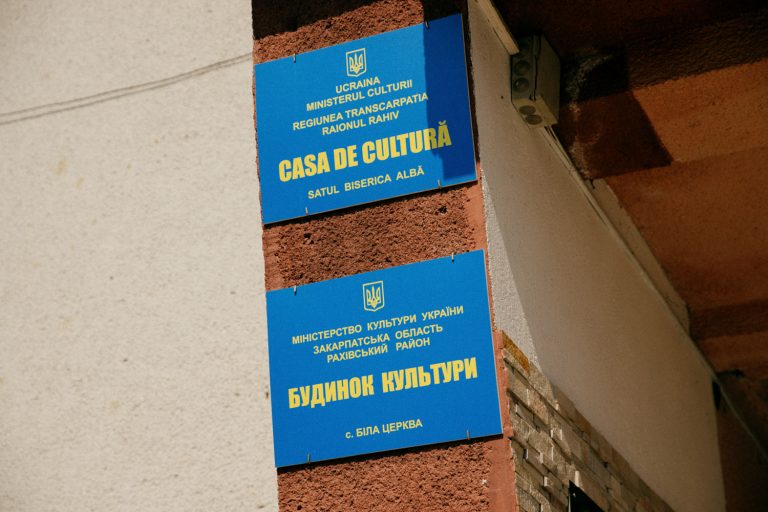
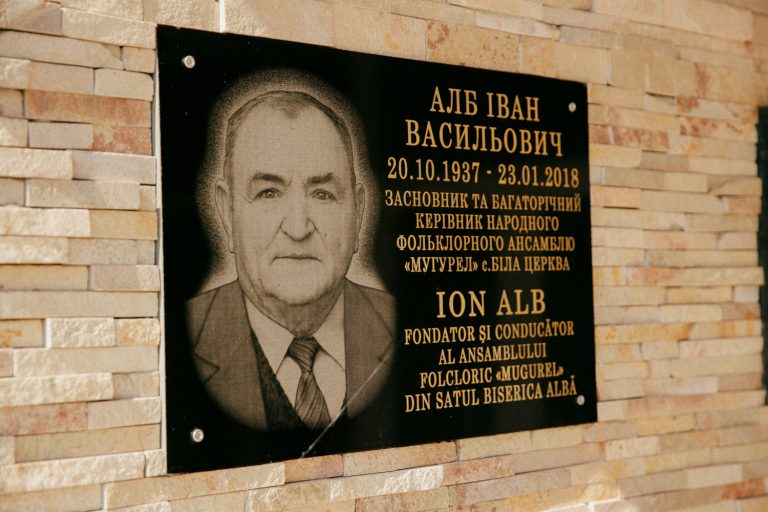
slideshow
Vasyl Țiple studied in Uzhhorod at the Romanian Philology faculty. It’s difficult for him to speak Ukrainian. He hesitates but tries his best anyway.
In Bila Tserkva, there are Hungarian, Romanian, and Ukrainian schools, Romanian lycée, and a boarding school. At Vasyl’s school, all teaching is done in Romanian. Almost all of the Romanian population speaks Romanian in their everyday lives. They use Ukrainian mostly during their Ukrainian lessons at school, when they talk to ethnic Ukrainians, or if they go to study in Uzhhorod.
The ratio of teaching in Ukrainian and Romanian at schools in Bila Tserkva and other Romanian settlements of Zakarpattia is regulated by two laws. The first one is the Law “On Education”. According to this law, by 2023 all local Hungarian and Romanian schools will have to increase the number of subjects taught in Ukrainian. The other law is the Law “On ensuring the functioning of the Ukrainian language as the state language”. It came into effect in July 2019. It requires gradually increasing the percentage of teaching in Ukrainian at schools: from Year 5 the minimum must be 20%, and by Year 9 at least 80% of subjects must be taught in Ukrainian.
Today, the Romanians of Zakarpattia have even more stimuli to preserve their language and culture.
— I am Ukrainian, but I speak Romanian, I teach in Romanian too, because in my view every child has the right to be taught in the language they want, or rather in their native language; every child has the right to bear their cultural heritage and to be able to share it with future generations.
Vasyl plans to stay in Ukraine for the time their Association functions and while his children are young.
— I received offers to move, but ever since starting a family of my own, I decided to stay. That was my motivation. I don’t completely rule out the possibility of moving to a bigger city or another country where I’d have more opportunities. But at the moment, I see the Association as an opportunity. That’s why I envision myself here for the foreseeable future. And, I would very much like my children to stay here for as long as they can. I want them to build their foundation here and then follow their dreams, wherever they want.

Vasyl jots something down in his notebook, crosses it out, and carefully selects the correct words in Ukrainian.
— Even though I speak Romanian, feel in Romanian, think in Romanian, and teach in Romanian, Ukraine remains my country, no matter what. This is where I was born. This land and these places are in Ukraine, and I’m proud that I’m Ukrainian. I’m a Ukrainian with a Romanian soul.

